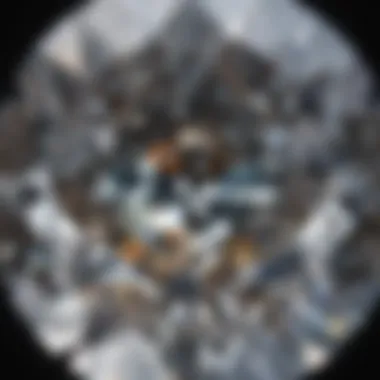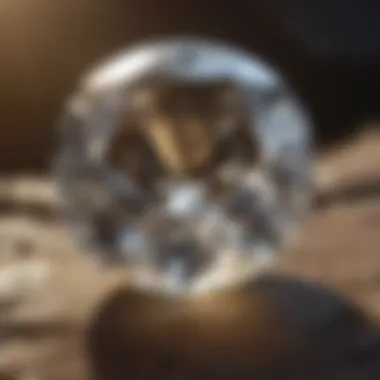Unveiling the Intricacies of Diamond Hardness Testing


Examining Diamond Hardness Tests
This section delves into the intricate details of the diamond hardness test, a fundamental procedure in evaluating the durability and authenticity of diamonds. Diamonds, being the hardest natural material, undergo a specific examination process to ascertain their quality. The tools utilized for this test are precise and specialized, reflecting the meticulous nature of gemstone analysis.
Conducting the Hardness Test
To initiate the hardness test on a diamond, specialized tools such as the Mohs hardness test kit are employed. This kit consists of various minerals of known hardness levels, facilitating the comparison and determination of the diamond's hardness. The examiner carefully scratches the diamond’s surface with these minerals, assessing the resulting markings to determine the diamond's precise hardness level.
Significance of Diamond Hardness
Understanding a diamond's hardness is critical in assessing its resistance to scratching and wear over time. Higher-quality diamonds exhibit greater hardness, signifying superior durability and long-term value. The hardness test sheds light on the diamond's ability to withstand external factors, making it an integral aspect of the gemstone's evaluation process.
Diamond hardness test is a crucial method in assessing the durability and quality of diamonds, revealing the exceptional nature of these precious gemstones. Dive deep into the intricacies of this process to gain a comprehensive understanding.
Introduction
In the realm of gemology, understanding diamond hardness is paramount. Diamonds are renowned for their strength and durability, making them highly coveted in various industries, especially jewelry-making. The hardness of a diamond is a significant factor that determines its value and longevity. By exploring diamond hardness, we uncover not just the physical properties of these gems but also their resilience and rarity.
Understanding Diamond Hardness
Formation of Diamonds
The formation of diamonds dates back millions of years, occurring deep within the Earth's mantle under extreme pressure and heat. This natural process results in the crystallization of carbon atoms into the iconic structures we recognize as diamonds. The unique journey from carbon molecules to the formation of diamond crystals brings forth their unparalleled hardness and radiance, making them a top choice for jewelry and industrial applications.
Significance of Hardness in Diamonds
The hardness of diamonds is a defining feature that sets them apart from other gemstones. With a rating of 10 on the Mohs Scale, diamonds exhibit exceptional resistance to scratching and abrasion. This extraordinary hardness not only enhances their aesthetic appeal but also ensures their durability over time. Understanding the significance of hardness in diamonds sheds light on why they are valued not just for their beauty but also for their robust nature.
Importance of Diamond Hardness Test
Purpose of Test
The diamond hardness test serves as a fundamental method for evaluating the quality and authenticity of diamonds. By subjecting diamonds to controlled testing conditions, gemologists can ascertain their resistance to external forces and assess their overall hardness level. This test is crucial in distinguishing natural diamonds from synthetic counterparts and determining the durability of these precious gems.
Application in Gemology


In the field of gemology, the diamond hardness test plays a vital role in gem identification and characterization. By utilizing this test, gemologists can categorize diamonds based on their hardness levels, providing valuable insights for distinguishing between various gemstone types. The application of the hardness test in gemology extends beyond just hardness assessment, contributing significantly to gemstone classification and authentication.
Overview of Diamond Testing Methods
Mohs Scale of Hardness
The Mohs Scale of Hardness, devised by Friedrich Mohs in 1812, is a qualitative method of ranking minerals based on their scratch resistance. Diamonds, being the hardest minerals, are positioned at the pinnacle of this scale with a hardness rating of 10. This scale serves as a reference point for comparing the hardness of different gemstones and is widely used in gemological practices for quick and preliminary assessments.
Vickers and Knoop Hardness Tests
In more precise hardness testing, the Vickers and Knoop tests are preferred methods for determining the hardness of diamonds and other materials. These tests involve the application of controlled pressure on the diamond surface, allowing for accurate measurement of hardness based on indentation size. The Vickers and Knoop hardness tests provide a quantitative assessment of hardness, offering detailed insights into the structural integrity and strength of diamonds.
Tools Required for Diamond Hardness Test
In the realm of examining diamond hardness, the tools required play a pivotal role in ensuring accurate and reliable results. These instruments form the foundation of the entire testing process, allowing gemologists and experts to delve deep into the intricacies of a diamond's durability and quality. The significance of the tools lies in their precision and capability to provide critical insights that shape the assessment of these precious gemstones. Furthermore, the tools required for a diamond hardness test offer a synergistic combination of functionality and accuracy, essential for conducting a thorough and meticulous evaluation.
Diamond Tester
Functionality
When it comes to diamond testing, the functionality of a diamond tester holds immense importance. The primary function of a diamond tester revolves around differentiating between genuine diamonds and diamond simulants based on their thermal conductivity properties. This functionality is a game-changer in the world of gemology, as it provides a quick and efficient method to verify the authenticity of diamonds. The key characteristic of a diamond tester's functionality lies in its ability to produce reliable results rapidly, offering gemologists a versatile tool to streamline their testing processes. One of the unique features of a diamond tester's functionality is its non-destructive nature, ensuring that the tested diamonds remain intact throughout the assessment. While the functionality of a diamond tester is widely acclaimed for its convenience and speed, it is imperative to note that its accuracy is highly dependent on proper calibration and user proficiency.
Accuracy
Accuracy is the cornerstone of any diamond hardness test, making it a fundamental aspect of the evaluation process. The accuracy of a diamond tester is crucial in determining the authenticity and quality of diamonds with precision. By providing consistent and reliable results, the accuracy of a diamond tester instills confidence in the obtained outcomes. The key characteristic of accuracy in a diamond tester lies in its ability to differentiate between various types of gemstones based on their thermal properties, ensuring a thorough and dependable assessment. One of the unique features of the accuracy of a diamond tester is its ability to detect potential diamond simulants, safeguarding against counterfeit gemstones in the market. While the accuracy of a diamond tester is highly valued for its efficiency and effectiveness, it is essential to acknowledge that external factors such as ambient temperature can influence its performance, necessitating careful consideration during the testing process.
Procedure for Diamond Hardness Test
The procedure for conducting a diamond hardness test holds immense significance in the gemological world. It acts as a pivotal tool in evaluating the durability and quality of diamonds, providing invaluable insights into their composition and robustness. By following a meticulous procedure, gemologists can accurately assess the hardness of diamonds, aiding in their classification and subsequent application in various industries.
Preparation Steps
Cleaning the Diamond
Cleaning the diamond is a fundamental step in the diamond hardness test process. By meticulously removing any impurities or contaminants from the diamond's surface, gemologists ensure an accurate assessment of its hardness and quality. The methodical cleaning procedure enhances the clarity of the diamond, allowing for a precise examination of its physical properties. This meticulous cleaning process is essential in guaranteeing the authenticity and integrity of the diamond being tested, laying the foundation for accurate hardness evaluation.
Setting Up Test Environment


Preparing the test environment is crucial for conducting a reliable diamond hardness test. Creating a controlled and consistent setting ensures accurate results and minimizes external factors' interference. The setup includes calibrating equipment, controlling temperature and humidity levels, and eliminating potential sources of contamination. A well-organized test environment guarantees the reliability and reproducibility of the hardness test results, providing precise data for further analysis.
Conducting the Test
Application of Pressure
The application of pressure is a critical aspect of the diamond hardness test. By subjecting the diamond to controlled pressure, gemologists can observe its resistance to deformation and assess its toughness. This process provides valuable information on the diamond's ability to withstand external forces, indicative of its overall hardness and durability. Careful application of pressure ensures accurate results, allowing for a comprehensive evaluation of the diamond's physical properties.
Observation of Results
Observing the results of the hardness test is a meticulous task that requires precision and attention to detail. Gemologists scrutinize the diamond's response to pressure, noting any changes in its structure or surface characteristics. By carefully examining the diamond post-test, they can determine its hardness rating and quality. This observation phase is crucial in deriving meaningful insights from the test results, guiding further analysis and decision-making processes.
Interpreting Test Findings
Hardness Rating
The hardness rating obtained from the test is a key indicator of the diamond's quality and durability. It quantifies the diamond's resistance to scratches and abrasions, reflecting its overall hardness level. Gemologists use the hardness rating to categorize diamonds based on their robustness and assess their suitability for various applications. This numerical representation plays a significant role in determining the value and utility of the diamond in both the jewelry and industrial sectors.
Quality Assessment
Quality assessment entails a comprehensive evaluation of the diamond's physical properties, beyond just its hardness. Gemologists analyze factors such as clarity, color, and cut to determine the overall quality of the diamond. This holistic approach allows for a detailed assessment of the diamond's worth and desirability, influencing its market value and consumer appeal. Quality assessment complements the hardness test findings, providing a well-rounded perspective on the diamond's characteristics and craftsmanship.
Factors Influencing Diamond Hardness
In the realm of gemology, understanding the various factors that influence diamond hardness is paramount to distinguishing the quality and durability of these exquisite gemstones. The hardness of a diamond is not solely defined by its chemical composition but also by external elements that can affect its structural integrity and resistance to scratching and other forms of wear. By delving into the factors that impact diamond hardness, gemologists and enthusiasts alike can gain a deeper appreciation for the complexities inherent in assessing these precious stones.
One significant aspect that contributes to diamond hardness is the presence of inclusions within the stone. Inclusions, which are internal flaws or imperfections, can have a direct impact on the overall hardness of a diamond. These imperfections can create weak areas within the structure of the gemstone, reducing its resistance to abrasion and potentially compromising its durability. As such, the type, size, and location of inclusions play a crucial role in determining the hardness rating of a diamond. Gemologists must meticulously examine these inclusions to assess their effect on the stone's hardness accurately.
Furthermore, the crystal structure of a diamond also plays a pivotal role in determining its hardness. Diamonds possess a unique hexagonal crystal structure that contributes to their renowned toughness and durability. This specific arrangement of atoms within the crystal lattice provides diamonds with exceptional hardness properties, making them highly resistant to scratching and wear. However, variations or dislocations within the crystal structure can affect the overall hardness of the diamond, emphasizing the importance of understanding the intricate relationship between crystal architecture and durability. Gemologists must consider the inherent characteristics of a diamond's crystal structure when evaluating its hardness and quality, ensuring a comprehensive assessment of its durability and value.
Applications of Diamond Hardness Testing
In this meticulous exploration of diamond hardness testing, the focus shifts towards its crucial applications. The significance of applying diamond hardness testing lies in its capability to assess the quality and durability of these precious gemstones with unparalleled precision. By delving into the realm of applications, a deeper understanding of the intrinsic properties of diamonds is revealed, shedding light on their remarkable resilience and excellence. Through the utilization of advanced testing methods, the applications of diamond hardness testing play a pivotal role in various industries, shaping the standards for quality and authenticity.
Jewelry Industry


Ensuring Quality
Within the jewelry industry, the aspect of ensuring quality through diamond hardness testing holds paramount importance. This specific facet of quality assurance is instrumental in guaranteeing the authenticity and durability of diamond jewelry pieces. The key characteristic of ensuring quality lies in its ability to accurately assess the hardness of diamonds, ensuring that only the highest quality stones are used in crafting exquisite jewelry. By incorporating this meticulous testing process, jewelry artisans can uphold the reputation of their creations, providing customers with a sense of trust and assurance in the value of their investment. The unique feature of ensuring quality in diamond hardness testing is its ability to distinguish between genuine diamonds and synthetic imitations, thereby safeguarding the integrity of the jewelry industry.
Detecting Synthetic Diamonds
Another critical aspect of diamond hardness testing in the jewelry industry is the detection of synthetic diamonds. This specialized application plays a crucial role in identifying man-made diamonds and differentiating them from natural formations. The key characteristic of detecting synthetic diamonds lies in its meticulous evaluation of the unique properties exhibited by lab-grown diamonds, allowing for accurate classification and verification. By leveraging this distinctive feature of diamond hardness testing, jewelers can maintain the authenticity and value of their products, ensuring that customers receive genuine and ethically sourced gemstones. While the process of detecting synthetic diamonds may pose certain challenges, its contribution to the jewelry industry is significant, establishing a foundation of trust and credibility among consumers.
Industrial Uses
Cutting and Drilling
In industrial applications, diamond hardness testing proves to be indispensable for tasks such as cutting and drilling. The key characteristic of utilizing diamond hardness testing for cutting and drilling purposes lies in the unmatched strength and durability of diamonds, enabling efficient and precise machining of various materials. This specialized application offers numerous benefits, including enhanced productivity, precision engineering, and extended tool lifespan. The unique feature of diamond hardness testing in cutting and drilling operations is its ability to withstand high-temperature and high-pressure environments, making it a preferred choice for industries requiring exceptional quality and performance.
Tool Manufacturing
For tool manufacturing processes, diamond hardness testing plays a vital role in enhancing the quality and durability of tools. The key characteristic of incorporating diamond hardness testing in tool manufacturing is the unparalleled hardness and wear resistance offered by diamonds, resulting in tools of superior strength and longevity. This specialized application provides a range of advantages, including increased efficiency, reduced maintenance costs, and improved overall performance. The unique feature of diamond hardness testing in tool manufacturing lies in its ability to create cutting-edge tools that outperform conventional counterparts, positioning companies at the forefront of innovation and excellence.
Challenges in Diamond Hardness Testing
In the realm of diamond hardness testing, challenges abound, shaping the landscape of gemological assessments and quality assurance. Understanding and addressing these challenges are paramount in ensuring the accuracy and reliability of hardness testing results. One of the primary challenges in this domain revolves around the issue of accuracy, which can significantly impact the effectiveness of assessments. To illuminate the significance of challenges in diamond hardness testing, we delve deeper into specific elements, benefits, and considerations guiding this crucial facet of gemstone evaluation.
Accuracy Issues
Subjectivity
Subjectivity, a critical facet of accuracy issues in diamond hardness testing, plays a pivotal role in the evaluation process. The subjective nature of assessments introduces a level of interpretation that can influence results and conclusions. This inherent subjectivity underscores the importance of expert judgment and experience in conducting precise hardness tests. While subjectivity can provide valuable insights into unique characteristics of diamonds, its reliance on individual assessment can also give rise to inconsistencies and variations in test outcomes. Navigating the balance between subjective analysis and objective standards is essential in mitigating potential biases and ensuring the integrity of hardness evaluations.
Environmental Factors
Environmental factors present another crucial dimension of accuracy challenges in diamond hardness testing. The external conditions and variables under which hardness tests are conducted can impact the reliability and reproducibility of results. Factors such as temperature, humidity, and lighting can influence the testing environment, potentially skewing outcomes and complicating interpretations. Controlling and standardizing these environmental factors are essential in minimizing their effects on hardness assessments. By acknowledging and addressing the influence of environmental variables, gemologists can enhance the precision and consistency of their testing procedures.
Cost Considerations
Delving into the cost considerations associated with diamond hardness testing unveils a multifaceted landscape of financial implications and strategic decisions. Balancing affordability with quality and accuracy is a nuanced challenge faced by professionals in the gemological industry. Two key aspects, affordability and professional services, emerge as focal points in understanding the economic dimensions of hardness testing.
Affordability
Affordability stands as a pivotal consideration in the context of diamond hardness testing, shaping the accessibility and feasibility of conducting thorough evaluations. The cost-effectiveness of testing methods, equipment, and services directly influences the scalability and sustainability of hardness testing practices. Finding a balance between cost and quality is essential in maximizing the value of hardness assessments while managing budget constraints. Deploying affordable yet effective testing strategies empowers gemologists to streamline processes without compromising the integrity of their evaluations.
Professional Services
The realm of diamond hardness testing encompasses a spectrum of professional services, offering specialized expertise and insights to enhance the quality and reliability of assessments. Engaging professional services in hardness testing can provide access to advanced tools, methodologies, and analytical approaches that elevate the sophistication of evaluations. The distinctive advantage of professional services lies in their capacity to deliver tailored solutions, personalized consultations, and comprehensive reports that aid in decision-making and knowledge acquisition. Leveraging the expertise of certified professionals can optimize the efficacy and professionalism of hardness testing endeavors, ensuring rigorous standards and exceptional outcomes.







